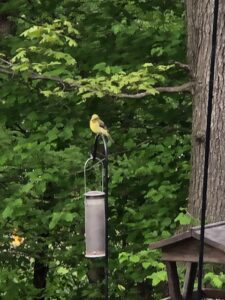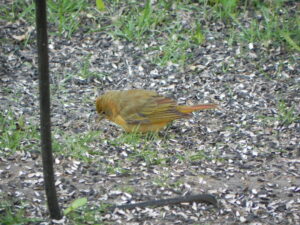by Winding Pathways | Jun 11, 2020 | Birds, Garden/Yard, Nature
We’re lucky. Scarlet tanagers nest near us. Winding Pathways abuts Faulkes Heritage Woods, a protected 110-acre forest of mostly monstrous oak trees. So, every May we’re delighted as this brilliant bird arrives and sets up home.
Male scarlet tanagers appear at our feeders in mid-May. Females come a few days later. The male’s amazingly brilliant red feathers and contrasting black wings make the bird unmistakable. For only a week or two they visit the orange-colored suet we set out and pick sunflower seeds from silo feeders. Then they disappear. We knew they abandoned our yard to nest near the tops of big oaks in the nearby woods, but they are very hard to spot there, even as they sally forth to catch insects from mid-air catching a meal. Their summer diet is mostly insects.
-
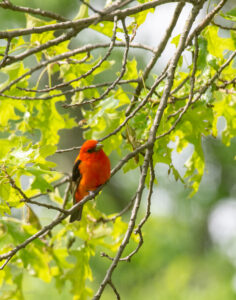
-
The male scarlet tanager arrives. several days ahead of the female.
-
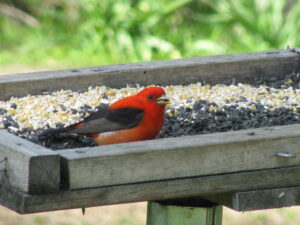
-
The tanagers willinging come to the platform feeder.
We wondered where they went after nesting and consulted our friend Jim Berry, retired executive director of the Roger Tory Peterson Institute in Jamestown, New York. Here’s what he wrote:
“Once the baby birds fledge, familial responsibilities end and the birds move away from forests to places where they can find food and molt. Often these are old fields and marshes, where they seem to disappear. This is called the post-season dispersal.
They soon replace their brilliant red feathers with duller-colored new ones that help them migrate.”
Jim told us we are lucky to have scarlet tanagers come to our feeders. They don’t where he lives in Western New York.
After they molt the birds fly all the way to northwestern South America for the winter. We won’t see them again until next May.
These are breathtakingly beautiful birds that brighten our yard for just a short while each year. We’re humbled to be able to host them.
by Winding Pathways | May 28, 2020 | (Sub)Urban Homesteading, Amphibians/Reptiles, Garden/Yard
For many years Rich wrote a nature column for the Cedar Rapids GAZETTE about little known aspects of natural history common in suburbia. He was amazed when more people responded to a column on toads than anything else he had written. People like toads. Some readers called him to talk about “their” toad that lives in the garden or a damp corner in the garage. They wondered what treats they could give “their” toad.
Toads Range Far and Wide
Toads herald spring’s arrival with lusty evening trilling, usually in May. Common and intriguing, they enjoy living in suburban yards as well as woodlands and wetlands.
Many toad species inhabit the world but the Eastern Toad is most common in the United States. It ranges from about Nebraska east to the Atlantic and from southern states north to nearly Hudson’s Bay in Canada.
Where do Toads Live?
Both toads and frogs are amphibians. (The bloopers at the end of this video are fun to watch! Shows what it takes to put together even one short educational video!)
Toads, however, spend much of their lives away from water. A damp shady place to live and plenty of insects and other invertebrates to eat suits their needs. Toads often spend the day hiding in damp garages, under rotting logs, and in secluded garden spots. Come evening they hop around seeking tasty bug meals.
As amphibians toads need standing water to reproduce. Each spring toads hop to ponds, wet road ditches, and big puddles to serenade the night with their loud trilling. Females lay two strings of eggs in the water that hatch into tadpoles within two weeks. The warmer the weather the faster the eggs hatch. Toad tadpoles are easy to recognize. They are tiny, black, and have bodies much larger than their thin tail. Often hundreds swarm in a small pool. In less than two months they change into mini toads that hop far and wide seeking a place to live. They’ll eventually grow to about three inches long.
-
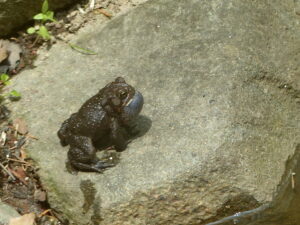
-
Toads sing loudly day and night.
-
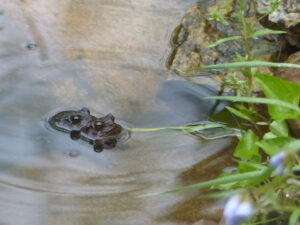
-
Toads need water to mate.
Who Eats Toads?
Although many animals enjoy a frog meal, few eat toads. When bothered toads often emit a foul-tasting liquid that makes a hungry dog or raccoon immediately drop the animal unhurt. Probably their main predator is the hognose snake, which relishes a toad meal.
Caring for “Your” Toad
Most people like toads and many gardeners create damp quiet places in their gardens for them to take shelter during the day and forage for pesky insects come nightfall. As for a toad treat, well, they really don’t need one but they might like to snack on a few mealworms or earthworms.
#
by Winding Pathways | May 21, 2020 | (Sub)Urban Homesteading, Garden/Yard
Planting Day
Saturday, May 9th was our big day. We planted our newest prairie and we’ll tell you how after we explain the ground preparation we did before a single seed was dropped to the ground.
We’ve established several prairies with no ground preparation by simply broadcasting seed on an existing lawn and waiting……a long time. For the first two years, there was little evidence of prairie, but we let the lawn grass grow tall and burned it each fall. By the third year, prairie plants started to appear. We continued annual burns and by the fourth and fifth year, it had more prairie than lawn plants, and every year it got better.
Shortcut Method
For our new prairie, we wanted to shortcut the process and get it established much faster. We knew that involved spraying the lawn with herbicide to kill the grass plants and weeds. Following spraying we’d till the area, smooth it out, and broadcast our prairie seeds. We had a problem. We lacked sprayers and machines, so months ago we hired Sustainable Landscape Solutions to spray and till.
On a Monday in late April, they arrived and sprayed the area we had marked off. It’s about 3000 square feet. The old turf began showing stress in a few days, but the sprayers had missed a few spots. They returned a week later and sprayed it again. On Friday, May 8 they arrived with a mini skid loader and rotadairon attachment. This amazing machine tilled up the now dead grass and left the area with a mild textured pattern that looked perfect for seeding.
-

-
Caitlin carefully applies spray.
-

-
The rotadairon machine quickly turns over the dirt.
Other Cooperators
We had bought a Leopold 2 seed mix from Pheasants Forever weeks ago and had it in storage. It contained a blend of at least 70 native wildflowers and some short profile grasses. We didn’t want tall big bluestem, switchgrass, or Indian Grass and asked that they be excluded from the mix. Allendan Seed Company removed the tall-growing seeds and added in some Little Bluestem, Sideoats Grama, and Prairie Dropseed. Our prairie will be mostly flowers with some grasses that don’t get tall. Prairie restorationists and botanists often call wildflowers forbs. It’s a useful word to know.
We had a problem. We’d bought enough seeds to cover a half-acre, but we were seeding only 3000 square feet, so we had about seven times too many seeds. Still, they only weighed 3.36 pounds and were all in a rather small bag. We decided to plant heavily and put them all on the new prairie.
Mixing Steps
Many prairie plant seeds are so tiny they’re hard to see. Some are fluffy and blow in the breeze. A technique helped us get an even planting. We dumped two gallons of fine sand into our wheelbarrow and poured in just enough water to make it damp…….not wet. Then while one of us mixed the sand with a shovel the other dribbled the prairie seeds on the sand and soon we had a sand/seed mix. We mixed about half the seeds, or three pounds, into about 30 pounds of sand.
The sand does at least three important things. First, it adds bulk to the seeding mix, making broadcasting easier. Second, tiny seeds cling to the moistened sand grains weighing them down. That way the sand and clinging seeds don’t blow in the wind and descend to the ground where we want them. Third, the sand we used was blond and it contrasted with the black dirt in the planting area. It helped us spot areas we had planted and get uniform coverage.
We put the sand and seed mix in small buckets and walked side by side gently broadcasting seed as we walked along. We paced ourselves so we covered the entire area about when half the seed/sand mix was exhausted. Then we mixed the rest of the seed with damp sand. We filled our buckets and walked across the area at right angles to our first seeding, broadcasting seed as we walked along. Soon the entire area was seeded as evenly as we could possibly do it.
After a short coffee break, we took leaf rakes and very lightly raked the area, pulling a thin layer of dirt over the seeds and ensuring good seed/soil contact. We were done.
-
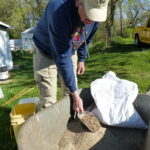
-
Rich mixes the seeds and sand with water.
-
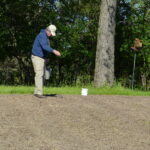
-
Rich broadcasts the sand-seed mixture on the newly tilled ground.
-

-
Gently rake the seeds in.
Other Considerations
Again, there are many ways to seed a prairie. Several commercially made seed drills work great and are most appropriate for big areas. And, many people have created small prairies by avoiding seeding completely and buying plugs of prairie plants from nurseries. Two good sources are Prairie Moon Nursery (www.prairiemoon.com) and Ion Exchange (www.ionxchange.com). Using plugs is expensive but works well for tiny prairies or when introducing new plants into an established prairie. Skipping the herbicide and tilling also works but takes several more years to establish the planting and some prairie plants may not be able to compete with existing lawn grass.
Now the Hard Part
Now, all we had to do was wait for gentle rain and warm weather to kindle germination.
Our next installment of blogs on our prairie restoration project will be about tools we use and the management of the newly seeded area. Tune in soon.
by Winding Pathways | May 15, 2020 | (Sub)Urban Homesteading, Flowers/Grasses, Garden/Yard, Garden/Yard
Moving Forward
Once we made the decision to convert about 3,000 square feet of our lawn to a prairie, we began active planning. We have 40 years of prairie establishment and management experience so it was easy for us, but we still needed help and sought partners.
We contacted many organizations and found support for our project from these people and groups:
Sustainable Landscape Solutions, a business based in Iowa City. We hired them to do ground preparation. Sean Pearl is the owner.
Monarch Research Project, an active Cedar Rapids-based group that encourages pollinator plantings.
Linn County Secondary Roads. Since our prairie is near a Linn County road we wanted their support.
Pheasants Forever. We received help from a biologist, Allie Rath, and bought an outstanding seed mix from Pheasants Forever. Matt O’Connor manages the seed store and encouraged us to buy a Leopold Mix that contains about 72 species of flowers. Our seeds were produced at the Allendan Seed Company in southern Iowa.
Good Neighbor Iowa. This organization encourages people to shun lawn chemicals and plant native vegetation. A key contact is Audrey Tranlam.
Requirements
We wanted the prairie to be diverse in plant species, establish as rapidly as possible, and be “short profile”. Meaning we did not plant tall big bluestem, Indian grass, and Switchgrass.
We chose the Leopold mix because it has a diversity of flowering plants. And, Pheasants Forever kindly removed the tall-growing grasses from the mix for us.
Preparing and Seeding
Years ago when we began restoring prairies at Indian Creek Nature Center, it was impossible to buy seed, and little was known about how to establish a healthy native grassland. The Center had no money to invest in planting. Jock Ingels was a savvy restorationist based in Illinois. He gave us this advice, “If you don’t have any money but want a prairie, go pick some seeds and broadcast them into the existing lawn. Then burn it. Then wait. You’ll think you wasted your time because nothing will show after a year or even two years but burn it annually. By the third year, you’ll see prairie plants appear and it will get better each year after.” He was right. We gathered seed, planted at the Indian Creek Nature Center, and burned it annually.
At the Nature Center, we got a prairie at no cost and avoided herbicides and ground preparation but it had a limited diversity of species. The newly established prairie was far healthier ecologically than the bromegrass that was once there. For the prairie we wanted to establish at our home, we wanted a more diverse prairie and more quickly. So, we chose a faster method. Mind you, we are not keen on sprays but recognize they have a place.
Sustainable Landscape Staff sprayed our lawn with roundup in late April to kill the grass. They returned one week later and resprayed it to kill the remaining grass.
-

-
Caitlin carefully applies spray.
-
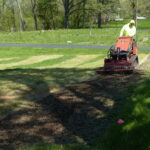
-
Tilling up the lawn.
-

-
Finishing the edge.
-

-
Three cooperators’ signs.
They returned a week later and rototilled the area to expose the soil. Spraying and tilling allows newly planted native seeds to grow with less competition from exotic lawn species. It emerges as a more diverse prairie faster than if spraying and tilling are avoided.
In the next installment of this series, we’ll show photos of us seeding the prairie and explain various other ways of establishing a prairie or pollinator meadow. But because lawns are now growing and people are mowing we’ll leave with this thought:
There’s a no-cost method of diversifying a lawn that reduces work. Simply mark off a section of the lawn and don’t mow it. It can be small. Many native plants have durable seeds that remain dormant in the soil for years or decades. They can’t succeed with constant mowing, so to increase plant diversity simply stop mowing a section of lawn and try to identify the new plants that emerge. You will help pollinators.
There’s a new phone app that we’re using to help identify plants we’re not familiar with. It’s called SEEK and is produced by the National Geographic Society, the California Academy of Science, and other groups. It’s free and can be accessed from the app store. You point the phone at a plant, insect, bird, or even a fungus, click a photo, and SEEK will identify it for you. It’s mostly accurate.
by Winding Pathways | May 7, 2020 | (Sub)Urban Homesteading, Garden/Yard, Nature
What’s to Love About a Prairie?

prairie forbs help pollinators
We love prairie. Prairie is color. Flowers yellow, red, blue, and every hue in between shine through tall grasses. Prairie beckons flying flowers……butterflies as well as birds, bunnies, and other interesting animals. Compared to a groomed July lawn, prairies are a joy to our eyes as grasses and flowers wave in the evening breeze.
When we moved to Winding Pathways in 2010, we inherited lawn. Lots of lawn. Starting almost immediately we transformed two big sections into a prairie. But we still had lots of lawn left. So, in late 2019 we decided to whittle it down by about another 3,000 square feet. In-place would be a short profile prairie sporting at least 70 species of wildflowers.
Lawns Have Their Purpose
We’re not anti-lawn. They are great places to relax with friends and play. There’s just too much lawn in America and its environmental impact is huge. Lawn watering annually consumes 3 trillion gallons of irrigation water, 200 million gallons of gas for mowing, and 70 million pounds of pesticides. There’s no need for that.
Ways to Ecologically Manage Lawns
- Allow diverse plants to grow.
- Avoid watering or spraying.
- Mow on a high setting. We use a battery-powered EGO mower that’s recharged by our solar electric panels.
There are lots of ways to establish a prairie. None is perfect. Some yield fairly quick results, while other methods require patience. Through a series of blogs this year we will detail how we decided to plant prairie, explain its benefits, and detail a way to achieve fairly fast results. Ours is just a model of one way to do it. We encourage anyone who has a lawn to consider transforming it into prairie or other native vegetation even if it’s only a few square feet.
Why We Are Doing It: Decision…
There are lots of reasons for converting a lawn to a prairie. Here are a few of ours:
- We’re individualists. We find neighborhoods with rows of perfectly clipped, fertilized, and sprayed lawns boring.
- We thrive on diversity. Every new bird, plant, and animal discovered in our yard is a thrill. Ecologists who have long said that diversity implies stability, are correct. Species change from year to year but always there’s change within the stability of a healthy habitat – our prairie.
- We consider mowing a waste of time and resources. Nationally, lawn mowing consumes millions of gallons of gas. Mowers spew out emissions that foul the air and contribute to climate change. Mowing is time-consuming.
- With a few exceptions, we shun chemicals. We’ve never used any insecticides and only use a few herbicides to help our prairie compete with persistent introduced plants.
- It’s all about beauty. As we sit on our summer porch colors dance in the wind from hundreds of blooming plants and butterflies hopscotch about. Prairie is a joy to the eye.
- Water is precious. Perhaps the world’s most precious resource is clean water. Deep-rooted prairie, unlike lawns, never needs irrigation. Instead, it filters, cleanses, and sequesters rain that percolates down to the water table through zillions of interlocking roots.
- Years ago, we restored one prairie. But on the other side of the drive is a swath of lawn that continually needed mowing. Worse yet, it was on a slope, causing our creaking knees to work extra hard pushing the mower upslope. So, in late 2019 we decided to convert part of it to a prairie, leaving a margin of a mowed lawn around it.
…and Early Preparation
So, we began to plan our newest prairie. Unlike the existing ones we wanted it to establish as quickly as possible and we wanted great plant diversity and lots of color with only one exception. We wanted a short-grass/forb prairie, so chose the seeds carefully. We chose not to include Big Bluestem, Switch, and Indian Grasses in our mix.
We also had to determine these things:
- Was it legal in our area? Yup. We checked ordinances.
- Would it bother the neighbors? No. We informed them and learned they were fine with it.
- Did we have the time and money to establish and maintain it? Yup. We are frugal and energetic enough to maintain and nourish the prairie.
Just What Is Prairie?
Native prairie is an enormously complex and beautiful grassland that became established in the American middle after the glaciers receded and the climate warmed and dried. It stretched from Ohio to the Rocky Mountains. Eastern prairies lived where rainfall and humidity were fairly high. It was nearly plowed to extinction and was replaced by vast corn and soybean fields. Shortgrass prairie can be just ankle high and lives in the dry Great Plains with the mid-grass prairie in between. We live in the area once occupied by tallgrass prairie, a truly endangered ecosystem. Establishing prairie is appropriate in areas that were once prairie and it is ecologically wonderful to replace lawns with vegetation native to the site.
Winding Pathways is partnering the project with the Monarch Research Project, Linn County Roadsides, Sustainable Landscape Solutions, and Pheasants Forever.
Now on to the next phases of our Prairie Renaissance. (For earlier background on pollinator patches read our blog of February 20, 2020.)
-

-
Columbine blooms early in the season
-
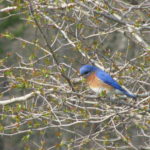
-
Bluebirds hang out on branches.
-

-
Blackeyed Susans populate a prairie.
-

-
Blue lobelia is one of the more demure forbs that attract pollinators.
-

-
Black Swallowtail butterfly on cup plant.
-

-
Culver’s Root sends up white candles of blooms.
-

-
High summer flowers like monarda and yellow coneflower attract butterflies
-
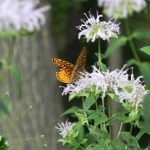
-
Summer is the time to attract and enjoy butterflies.
-

-
Compass plant is among the late summer forbs.
by Winding Pathways | Apr 16, 2020 | (Sub)Urban Homesteading, Garden/Yard, Nature, Pests
Lyme Disease is something you just don’t want. Rich has had it twice. It was no fun, and he was lucky. Nearly as soon as symptoms appeared, he visited our family physician. She prescribed a powerful antibiotic that worked wonders and left him with no lingering problems. Unfortunately, many Lyme Disease victims suffer pain and fatigue for years. It’s serious.
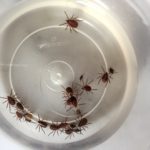
Collection of ticks
Lyme is often transmitted to a human from a bite by a tiny tick that picked up the disease bacteria from an infected white-footed mouse. It once was thought that deer were the primary carrier but mostly they are host to a tiny larval tick that infects a mouse that allows another tick to infect a person.
In theory, eliminating white-footed mice from a yard and home will greatly reduce the odds of transmission of this disease to people. Killing all of them isn’t feasible but reducing their numbers is.
About White-Footed and Deer Mice
White Footed and Deer Mice are amazingly common across much of North America. They’re the cute, native mouse, not to be confused with the common house mouse that originated in the Old World.
White Footeds naturally live in dry temperate forests with brush. That perfectly describes suburban landscaping. It’s likely that five to 20 white-footed mice live in close proximity to most suburban families. They’re nocturnal and rarely seen.
Here are some characteristics:
- They’re hoarders. Find a cache of corn, dog food, or acorns in a shoe or empty can and you’ve found a white-footed mouse cache.
- They reproduce like crazy. A 44-day old female can become pregnant and bear a litter after 22 to 28 days. Babies become independent in three weeks and soon begin having their own babies. Mom often has two to four litters a year.
- They don’t live long. A year-old mouse is elderly.
- Foxes, weasels, hawks, owls, coyotes, and many other predators love dining on mice.
- White Footed mice enjoy coming into homes, where they often find food and enjoy a furnace’s warmth. They can bring with them disease-bearing ticks.
Prudent homeowners carefully manage ticks, in part by reducing white-footed mice numbers. The fewer mice that live near people the lower the odds a person will contract Lyme Disease. So, managing mice and ticks makes for a healthier home and yard. Here are a few tips:
To reduce mouse populations and entry to homes:
- Welcome mouse predators. Karla Bloem, Executive Director of the International Owl Center says, “Two actions people can take to encourage owls are to protect large dead trees that aren’t a threat to people of buildings should they fall. Owls love them. Also, building and erecting an owl house can welcome owls to live near a home and catch and eat mice.” Barred owl nest box plans, and plans for many other birdhouses, can be found at www.nestwatch.org.
- Plug up holes that allow mice to enter a home and replace worn or broken weatherstripping. This is an important fall maintenance that also keeps cold drafts outside and reduces heating bills.
- Avoid feeding mice. They love dining on dog or cat food left in a dish overnight or birdseed left under a feeder. Only feed pets and wild birds what they can eat in a short time. Then, pick up and clean the pet bowl.
- Use snap traps to kill mice in the house. Avoid poison. A poisoned mouse can stagger outside to be caught and eaten by an owl, which can sicken or die from the poison.
A Few More Ways to Reduce Lyme Disease
In addition to reducing mouse numbers and applying a vaccine to keep survivors free of Lyme Disease bacteria here are a few other ways a person can do to reduce odds of infection:

Pants, boots, gaiters and insect repellents help protect from ticks.
Use Permethrin: When applied to clothing, not skin, this chemical repels and kills ticks. Rich purchased several sets of clothing from the Insect Shield Company that are impregnated with permethrin. Supposedly the tick-killing effectiveness lasts for 70 washings. The chemical is also available in spray cans to apply to any clothing.
Do Tick Checks: After being outside, strip down and check the body over for ticks. Then take a hot sudsy shower. Ticks usually crawl around on a person for several hours before biting. A tick merely walking on the skin can’t infect a person.
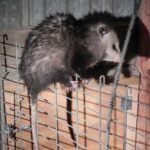
Opossums groom themselves carefully.
Thank and welcome opossums: New research indicates that opossums are tick vacuum cleaners. Ticks climb on them, but these primitive mammals groom often and eat the ticks they remove from their fur and skin. If you have a possum living in the yard be happy.
An Emerging Tool in the Battle Against Lyme Disease
A new product is being developed and tested by a major research company. It is an oral nontoxic vaccine placed in small baits. When strategically positioned around a yard, mice not yet infected with Lyme bacteria eat it and become resistant to the bacteria. Mice uninfected by Lyme can’t spread the disease to a person. If all goes well this product will be on the market by 2021 and may be a major help in reducing human cases of Lyme Disease.
Lyme Disease is an awful condition. Taking precautions to reduce the odds of being infected makes sense.
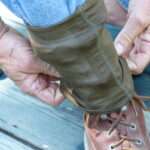
gaiters with tick guard help repel ticks.



